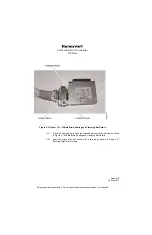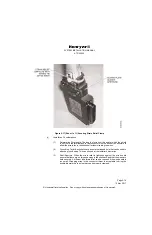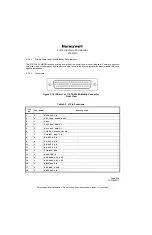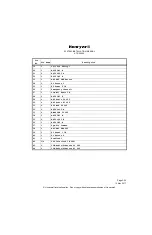
SYSTEM INSTALLATION MANUAL
KTR 2280A
Page 2-5
15 May 2017
© Honeywell International Inc. Do not copy without express permission of Honeywell.
• Use the template included in the installation kit to mark the mounting holes on the aircraft fuselage.
• Drill and/or punch the required holes.
• Use a piece of fine sandpaper or emery cloth to sand the area on the fuselage skin on which the
backup plate is to be mounted.
• Apply Alumiprep No. 33, PN 016-01127-0000, to both the inside area of the fuselage and the back
of the doubler plate, following the directions on the container to cleanse the metal of any residue.
• Apply Alodine No. 1001, PN 016-00128-0000, to both locations following the directions on the
container. This is used to ensure good bonding and prevent oxidation.
• Refer to the installation manual and mount the antenna as shown. First rivet the doubler plate in
place. It is imperative that the doubler plate make a good ground plane contact with the inside of
the aircraft skin.
• Prepare the ADF RF cable as shown in Figure 2-1 thru Figure 2-11 Quadraxial Cable Preparation.
Note that the cable provided can be cut to length as required for the installation.
2.3.5 KTR 2280A Wiring and Cable Installation
2.3.5.1 KTR 2280A Interconnection and Cable Harness Fabrication
The KTR 2280A MMDR receives primary power from the aircraft power source. A typical interface is shown in
Figure 2-24 KTR 2280A Interconnect Diagram. Aircraft specific interfaces with more details are provided in
separate EB or Installation Drawings.
The length of the wires to parallel pins must be approximately the same length, so that the best distribution of
current can be effected. Honeywell recommends that all wires, including spares, as provided with the
interconnect definition information be included in the fabrication of the wiring harness. However; if full wiring is
not desired, the installer must ensure that the minimum wiring requirements for the features and functions to be
used have been incorporated.
When cables are installed in the aircraft, they must be supported firmly enough to prevent movement and must
be carefully protected against chafing. Additional protection must also be provided in all locations where the
cable can be subjected to chafing.
In wire bundles, the cabling must not be tied tightly together as this tends to increase the possibility of noise
pickup and similar interference. When routing cables through the aircraft the cables must cross high level RF
lines at right angles.
Prior to installing any equipment, make a continuity check of all wires and cables associated with the system.
Then apply power and check for proper voltages at system connectors, and then remove power before
completing the installation.
The following guidelines are recommended:
(1) The installing facility will supply and fabricate all external cables. The required connec-
tors are supplied as part of the installation kit (Refer to 1.4.1 KTR 2280A Installation
















































